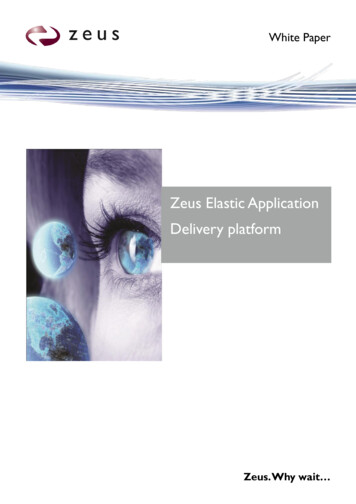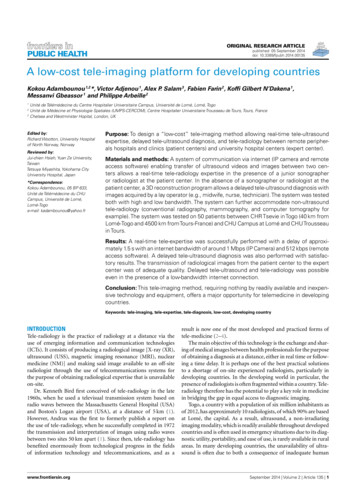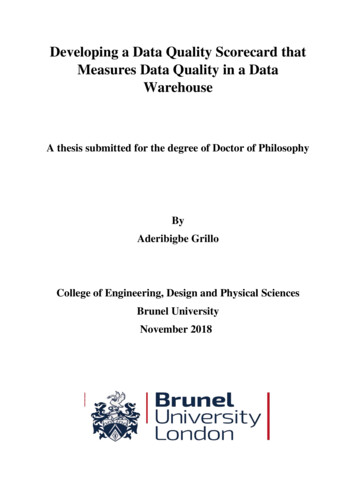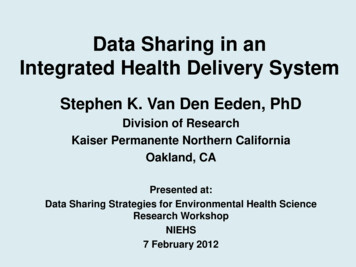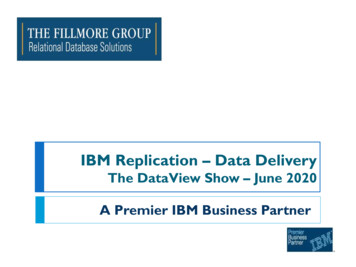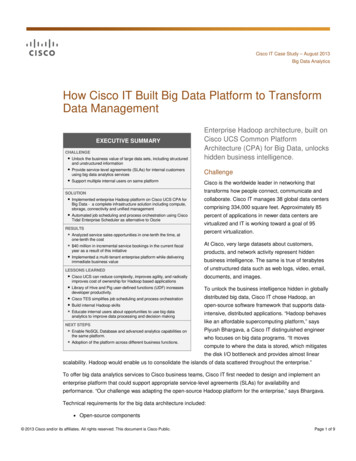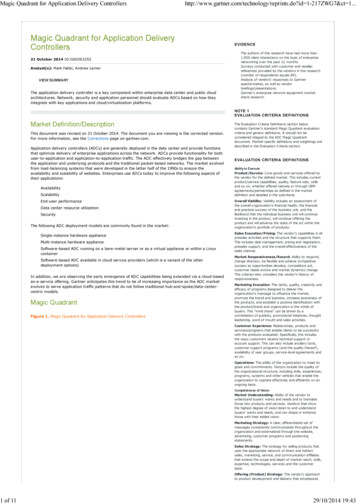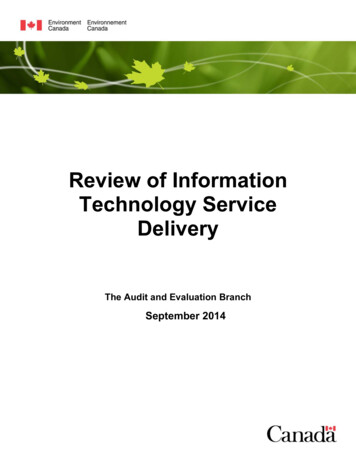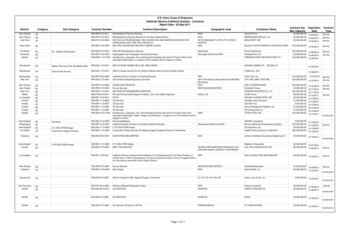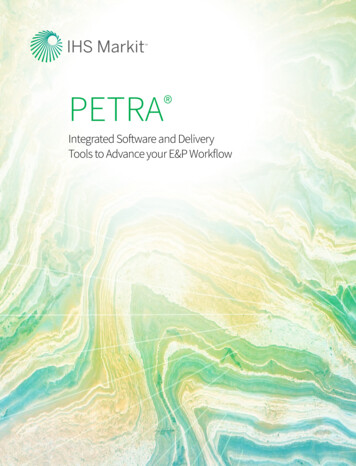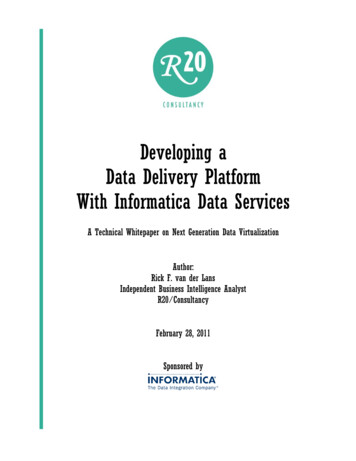
Transcription
Developing aData Delivery PlatformWith Informatica Data ServicesA Technical Whitepaper on Next Generation Data VirtualizationAuthor:Rick F. van der LansIndependent Business Intelligence AnalystR20/ConsultancyFebruary 28, 2011Sponsored by
Copyright 2011 R20/Consultancy. All rights reserved. Informatica Data Services andInformatica PowerCenter are registered trademarks or trademarks of Informatica Corporation.Trademarks of other companies referenced in this document are the sole property of theirrespective owners.
Table of Contents1. Summary 12. Business Intelligence Trends 23. What is the Data Delivery Platform? 44. Advantages of the Data Delivery Platform 55. Data Virtualization, Data Federation, and Data Integration 86. Open versus Closed Federation Servers 107. Federation Servers offer On-Demand Transformation 118. On-Demand Transformation and Cleansing 149. Application Areas of Federation Servers 1510. What is Informatica Data Services? 1611. Informatica Data Services Under the Hood 1812. Defining Virtual Tables 1813. Defining Physical Data Objects 2214. Defining Data Object Mappings 2415. Processing the Mappings by Translating them into SQL 2616. Sharing Specifications by Stacking Virtual Tables 2717. Integrated and On-Demand Data Profiling 2918. Collaborative and On-Demand Data Cleansing 3119. Developing Virtual Data Marts 3320. Transforming XML Documents and Spreadsheets to Tables 3521. Keeping Track of All Relationships 3822. Exposing Virtual Tables as Web Services 3823. Caching Virtual Tables 4124. Optimization Techniques for Accessing Foreign Data 4325. Security Features 4726. Inserting, Updating, and Deleting Data 4827. Technical Advantages of Informatica Data Services 4828. Business Advantages of Informatica Data Services 5029. Case Studies 51About the Author Rick F. van der Lans 55About Informatica Corporation 55Copyright 2011 R20/Consultancy, All Rights Reserved.
Copyright 2011 R20/Consultancy, All Rights Reserved.
Developing a Data Delivery Platform with Informatica Data Services11 SummaryThe Data Delivery Platform (DDP) is a modern architecture for developing business intelligencesystems where data consumers, such as reporting and analytical tools, are decoupled from datastores. This whitepaper describes how to develop such a business intelligence (BI) architectureusing Informatica’s new data integration product Informatica Data Services. The concepts andfacilities of this product are described in such a way that developers and BI specialists get afeeling of how this product works, what its features are, and what it would mean to develop aDDP-based business intelligence architecture using this product.The Data Delivery Platform is a business intelligence architecture that offers many advantagesfor developing BI systems, including increased flexibility of the architecture, shareabletransformation and reporting specifications, easy migration to other data store technologies, costreduction due to simplification of the architecture, easy adoption of new technology, andtransparent archiving of data. The DDP can co-exist with other more well-known architectures,such as the Data Warehouse Bus Architecture, and the Corporate Information Factory.Informatica Data Services (Informatica Data Services) is a data integration platform. Basically,it’s a data federation and virtualization server extended with more classic ETL (ExtractTransform Load) functionality. Informatica Data Services can present a heterogeneous set ofdata stores as one logical data store. This unified view can be used by almost any reporting andanalytical tool, and in addition it can be accessed by applications through service-orientedinterfaces. Informatica Data Services offers the following features: On-demand (i.e. real-time or federated) and scheduled (i.e. batch) data integrationcapabilities in a single environmentIntegrated collaborative data profiling and on-demand data cleansing featuresWide range of transformation operations, including complex transformations andcleansing operationsShareable transformation specificationsIntegrated lineage and impact analysisAdvanced security rules for data accessAdvanced query optimization techniquesSophisticated caching mechanismAccess of any type of data source (e.g. structured, unstructured, semi-structured, cloud,archived)Easier data store migrationIntegration of cloud data sourcesTransparent archiving of data and federation of production and archived dataPure ETL tools integrate data using scheduled transformation while traditional data federationservers limit users to transformations offered by SQL or XQuery. Scheduled transformationmeans that the data stores accessed by the reporting tools are refreshed periodically. It alsomeans that several derived data stores must be developed and maintained to store theCopyright 2011 R20/Consultancy, All Rights Reserved.
Developing a Data Delivery Platform with Informatica Data Services2periodically copied data. With on-demand transformation, data is retrieved from the data storesthe moment reporting tools request data, and only then is the data transformed. The advantagesof scheduled transformation are that users can work with more timely data, less need exists forcreating and managing derived data stores, and report and transformation changes can beapplied more quickly. Informatica Data Services supports both scheduled and on-demandtransformations including mid-stream data profiling of federated data and application of dataquality rules in real-time on the federated data. These features make Informatica Data Servicesideal for developing a Data Delivery Platform.To summarize, Informatica Data Services is an advanced, mature, and feature-rich open datafederation and data virtualization server. It elegantly combines typical federation or datavirtualization features with those of an ETL solution. This makes the product suitable forscheduled and on-demand transformations. Informatica Data Services modular approach,flexibility, support for standards, and extensive optimization technologies make it very wellsuited for developing a business intelligence system based on the Data Delivery Platformarchitecture.2 Business Intelligence TrendsThe reporting and analytical needs of managers and decision makers have changed over time.In the beginning, users were satisfied if they could run simple reports that would, for example,show them the total amount of sales per region. In addition, the list of reports they could runwas normally pre-defined; they couldn’t develop new reports themselves. That was done byreporting specialists in the IT department.It didn’t take very long before users requested more advanced analytical and ad hoc capabilitiesthat would allow them to create new reports themselves. To address user needs, vendorsreleased so-called managed query tools followed by OLAP tools (OnLine Analytical Processing).Both classes of tools gave users more dynamic query capabilities, such as drill-downs, rollups,and the ability to create new reports themselves. They were able to do all this without having tounderstand SQL or database technology. But the need for more analytical capabilities didn’tstop here. Users continued to increase their demands and needs. Some of those new reportingand analytical trends are:Operational Reporting and Analytics – Most current business intelligence architectures offerusers access to data that is one day, one week, or maybe even one month old. For a long timethis was good enough for most users. Nowadays, more and more users are demanding access todata that is (almost) 100% up-to-date. In other words, these users want to work with (near) realtime data. This new form of reporting and analytics is usually referred to as operationalreporting and analytics.There are many examples of environments that need operational reporting and analytics. Forexample, a retail company might want to know whether a truck already on the road to delivergoods to a specific store should be redirected to another store that has a sudden, more urgentCopyright 2011 R20/Consultancy, All Rights Reserved.
Developing a Data Delivery Platform with Informatica Data Services3need for those products. It would not make sense to execute this analysis with yesterday’s data.Another example is credit card fraud detection. A classic form of credit card fraud is when stolencard data is used to purchase products. Each new purchase has to be analyzed to see if it fits thebuying pattern of the card owner and whether the purchase makes sense. One of the checkscould be whether two purchases in different cities occurred within a limited time of each other.For example, if a new purchase is made in Boston and the previous one was in San Franciscojust a few seconds earlier, it’s highly likely this is a case of fraud. But this form of analysis onlymakes sense on operational data and additionally requires some way to resolve data inaccuraciesand inconsistencies instantaneously.Deep Reporting and Analytics – For many reports and forms of analytics, storing detailed datais not necessary; aggregated data or slightly aggregated data is sufficient. For example, todetermine the total sales per region, no need exists to store and analyze all the individual salesrecords. Aggregating the data on, for example, customer number is probably adequate. But forsome forms of analytics, detailed data is needed. This is called deep analytics or big dataanalytics. If an organization wants to analyze whether trucks should be rerouted, or if it wants todetermine which online ad to present, detailed data must be analyzed. And the most well-knownarea that requires detailed data is time-series analytics. The consequence of analyzing detaileddata is that the data stores will grow enormously, potentially leading to serious problems withquery performance.Self-Service Reporting and Analytics – Before users can run their reports, the IT departmentmust set up an entire environment, which takes some time. Self-service reporting and analyticsimplies that users can develop their own reports with a minimal setup required. Self-servicereporting is useful when a report must be developed quickly and there is no time to prepare acomplete environment. For example, an airline wants to know how sales will be affected by aparticular strike tomorrow. Another example is when a requested report will be used only once.In that case, self-service analytics can be very helpful. For both examples, it would not makesense to first develop a dedicated data store and ETL scripts to fill the data mart before runningthe reports. For the first example, creating the derived data store would take too long, and forthe second example, it’s not worth the effort.Complex Reporting and Analytics – The complexity of user demands keeps increasing.Besides standard reports, users want to create and run complex statistical models. They maywant to create forecasting models (i.e. a retailer might want to see the impact of a price increaseon expected sales), predictive models (i.e. an insurance company might want to predict whichcustomers will be more interested in particular insurance combinations), and optimizationmodels (i.e. a transportation company wants to know what the most efficient route is for a truckto deliver goods to various stores). Some of these are pure data mining algorithms requiringcomplex to very complex queries. And for some of them, large portions of the data warehousemust be scanned.To summarize, these new forms of reporting and analytics require that more data, and alsomore detailed data, must be stored, access to more up-to-date is required, and the infrastructureshould be more flexible. These new demands will have a serious impact on the supportingbusiness intelligence architecture. This architecture normally consists of data stores, such as dataCopyright 2011 R20/Consultancy, All Rights Reserved.
4Developing a Data Delivery Platform with Informatica Data Serviceswarehouses, operational data stores, and data marts, and of ETL logic to transform, cleans, andcopy data between data stores. With most of the current business intelligence architectures,implementing these new demands will be hard. New architectures are needed. One of those newarchitectures is the Data Delivery Platform which is described in the next section.3 What is the Data Delivery Platform?The Data Delivery Platform (DDP) is a flexible architecture for developing business intelligencesystems where data consumers (such as reports developed with SAP BusinessObjectsWebIntelligence, SAS Analytics, JasperReport, and Excel) are decoupled from data stores (suchas data warehouses, data marts, and staging areas); see Figure 1.Figure 1 The Data Delivery PlatformThe Data Delivery Platformtandioarat ere amct asetu datl d ousuacabtr hod arudant repr datstc e waunelnaer atatdxbecuhdsearspeetIn a more classic business intelligence architecture reporting tools normally access data storesdirectly. In a way, they are tied to those data stores. In the DDP they are not accessing datastores but an intermediate layer of software. This layer makes sure that requests from the dataconsumers are directed to the right data store(s). Because of the intermediate layer, the dataconsumers don’t know (nor do they have to) from which data store(s) the data is coming from. Itcould be that a particular report is receiving the requested data from the central datawarehouse, the other from a combination of a data mart and a spreadsheet, and the third fromthe combination of a production database and two cubes.The primary goal of decoupling is to get a higher level of flexibility. For example, changes madeto the data stores don’t automatically imply that changes must be made to the data consumers aswell, and vice versa. Or, replacing one data store technology by another is easier when that datastore is ‘hidden’ behind the DDP.The DDP was introduced in a number of articles published at BeyeNETWORK.com, includingCopyright 2011 R20/Consultancy, All Rights Reserved.
Developing a Data Delivery Platform with Informatica Data Services5The Definition of the Data Delivery Platform1. The definition of the DDP is:The Data Delivery Platform is a business intelligence architecture that delivers data andmeta data to data consumers in support of decision-making, reporting, and data retrieval;whereby data and meta data stores are decoupled from the data consumers through ameta data driven layer to increase flexibility; and whereby data and meta data arepresented in a subject-oriented, integrated, time-variant, and reproducible style.Decoupling data consumers from data stores is based on the concept of information hiding. Thisconcept was introduced by David L. Parnas2 in the 70s and was adopted soon after by objectoriented programming languages, component based development, and service orientedarchitectures. The concept of information hiding is slowly receiving more interest in the world ofdata warehousing. However, the terms currently used to refer to this concept are dataabstraction and data virtualization.The DDP can be seen as a separate business intelligence architecture, but it can also co-exist withmore well-known architectures, such as Ralph Kimball’s Data Warehouse Bus Architecture3, BillInmon’s Corporate Information Factory4, and his more recent architecture called DataWarehouse 2.05. In addition, some other generic architectures exist, such as the CentralizedData Warehouse Architecture and the Federated Architecture; see the article Which DataWarehouse Architecture is Most Successful? by T. Ariyachandra and H.J. Watson, published in20066.We would like to emphasize that it’s not the intention of the DDP to replace the data warehouseconcept, but to complement it. In most organizations, production systems have been developedin such a way that a data warehouse will always be needed for reporting. One reason might bethat if a production system doesn’t keep track of historical data, that data has to be keptsomewhere else, for example in a data warehouse. Another reason might be that the currentworkload on the production systems is so intense, that reporting directly on the productiondatabases, might lead to too much interference. Again, a data warehouse might be the solution.1See 495.David L. Parnas, ‘Software Fundamentals, Collected Papers by David L. Parnas’, Addison-WesleyProfessional, 2001.3R. Kimball et al., The Data Warehouse Lifecycle Toolkit, Second Edition, John Wiley and Sons, Inc.2008.4W.H. Inmon, C. Imhoff, and R. Sousa, Corporate Information Factory, Second Edition, John Wiley andSons, Inc., 2001.5W.H. Inmon, D. Strauss, and G. Neushloss, DW 2.0, The Architecture for the Next Generation of DataWarehousing, Morgan Kaufmann Publishers, 2008.6See .aspx?ID 7890.2Copyright 2011 R20/Consultancy, All Rights Reserved.
Developing a Data Delivery Platform with Informatica Data Services64 Advantages of the Data Delivery PlatformAs indicated, the Data Delivery Platform (DDP) is a business intelligence architecture. Twoprinciples are very fundamental to this architecture: shared specifications and decoupling ofdata consumers and data stores. Both these principles lead to a number of advantages that aredescribed in this section.Most reporting and analytical tools require specifications to be entered before reports can bedeveloped. Some of those specifications are descriptive and others are transformative. Examplesof descriptive specifications are definitions of concepts; for example, a customer is someone whohas bought at least one product, and the Northern region doesn’t include the state Washington.But defining alternative names for tables and columns, and defining relationships between tablesare also descriptive specifications. Examples of transformative specifications are ‘how shouldcountry codes be replaced by country names’, and ‘how should a set of tables be transformed toone cube’. In the DDP those specifications are centrally managed and are shareable. Theadvantages resulting from shared specifications are:Easier Maintenance of Specifications – Unfortunately, in most cases, descriptive andtransformative specifications can’t be shared amongst reporting and analytical tools. So, if twousers use different tools the specifications must be copied. The advantage of the DDP is thatmost of those specifications can be defined once and can be used by all the tools. Therefore,maintaining existing and adding new specifications is easier, which makes self-service reportingand analytics easier to implement.More Consistent Reporting – If all reporting and analytical tools use the same specifications todetermine results, the results will be consistent, even if the tools are from different vendors. Thisimproves the perceived quality of and trust in the business intelligence environment.Increased Speed of Report Development – Because most specifications already exist within theDDP and can be re-used, it takes less time to develop a new report. Development can focusprimarily on the use of the specifications.In a DDP data consumers are decoupled from the data stores. This means that the dataconsumers don’t know which data stores are being accessed: a data warehouse, a data mart, oran operational data store. Neither do they know which data store technologies are beingaccessed, an Oracle or DB2 database or maybe Microsoft Analysis Service. The advantagesresulting from this decoupling are:Easier Data Store Migration – The DDP offers data store independency which means that if areport accesses a particular data store it can easily be migrated to another. The reports’ queriescan be redirected through the DDP to that other data store. For example, if a report is currentlyaccessing a data mart, migrating it to the d
Informatica Data Services (Informatica Data Services) is a data integration platform. Basically, it’s a data federation and virtualization server extended with more classic ETL (Extract Transform Load) functionality. Infor
